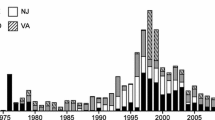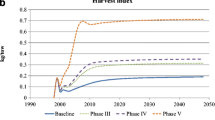Abstract
Mangroves are considered ecologicallyimportant due to their role as breedinggrounds and nursery habitats for off-shorefisheries. However, mangrove deforestationthrough conversion to shrimp aquaculturethreatens this valuable function. This paperdevelops a ‘dynamic’ production functionapproach to analyze the influence of habitatchanges on an open access fishery that faces afinite elasticity of demand. The basic modelis applied to a case study of the impacts ofmangrove deforestation on the artisanal marinedemersal and shellfish fisheries in Thailand. By estimating parameters through pooledtime-series and cross-sectional data over the1983–1993 period for the five coastal zones ofSouthern Thailand, the welfare impacts ofmangrove deforestation are estimated underdifferent elasticity of demand assumptions. Under pure open access, the welfare lossesestimated for mangrove deforestation inThailand of 30 km2 annually ranged from$12,000 to $408,000 depending on theelasticity of demand.
Similar content being viewed by others
References
Bantoon, S. (1994), ‘Using Simulation Modeling and Remote Sensing Technique for Impact Study of Shrimp Farms on Mangrove Area and Aquatic Animal Production at Welu Estuary, Khlung District, Chantaburi Province’, Unpublished M.Sc. Thesis. Chulalongkorn University, Bangkok.
Barbier, E.B. (1994), ‘Valuing Environmental Functions: TropicalWetlands’, Land Economics 70(2), 155–173.
Barbier, E.B. (2000), ‘Valuing the Environment as Input: Applications to Mangrove-Fishery Linkages’, Ecological Economics 35: 47–61.
Barbier, E.B. and I. Strand (1998), ‘Valuing Mangrove-Fishery Linkages: A Case Study of Campeche, Mexico’, Environmental and Resource Economics 12, 151–166.
Bell, F.W. (1989), Application of Wetland Valuation Theory to Florida Fisheries. Report No. 95, Florida Sea Grant Program, Florida State University, Tallahassee.
Bell, F.W. (1997), ‘The Economic Value of Saltwater Marsh Supporting Marine Recreational Fishing in the Southeastern United States’, Ecological Economics 21(3), 243–254.
Clark, C. (1976), Mathematical Bioeconomics, John Wiley and Sons, New York.
Coastal Resources Institute (CORIN) (1995), ‘The Effect of Aquaculture on Agricultural Land and Coastal Environment’, Mimeo. Prince of Songkhla University, Songkhla, Thailand.
Ellis, G.M. and A.C. Fisher (1987), ‘Valuing the Environment as Input’, Journal of Environmental Management 25, 149–156.
Farber, S. and R. Costanza (1987), ‘The Economic Value of Wetlands Systems’, Journal of Environmental Management 24, 41–51.
Freeman, A.M. (1991), ‘Valuing Environmental Resources Under Alternative Management Regimes’, Ecological Economics 3, 247–256.
Freeman, A.M. (1993), The Measurement of Environmental and Resource Values: Theory and Methods. Resources for the Future, Washington DC.
Greene, W. (1993), Econometric Analysis, 2nd ed. Macmillan, New York.
Hassani, K.K. (1993), ‘Coastal Aquaculture Development in Thailand’, paper presented in the International Seminar on Remote Sensing for Coastal Zone and Coral Reefs Application. October 30–November 1, 1993. Asian Institute of Technology, Bangkok.
Kahn, J.R. (1987), ‘Measuring the Economic Damages Associated with Terrestrial Pollution of Marine Ecosystems’, Marine Resource Economics 4, 193–209.
Kahn, J.R. and W.M. Kemp (1985), ‘Economic Losses Associated with the Degradation of an Ecosystem: The Case of Submerged Aquatic Vegetation in Chesapeake Bay’, Journal of Environmental Economics and Management 12, 246–263.
Kaosa-ard, M. and S.S. Pednekar (1998), Background Report for the Thai Marine Rehabilitation Plan 1997–2001. Report submitted to the Joint Research Centre of the Commission of the European Communities and the Department of Fisheries, Ministry of Agriculture and Cooperatives, Thailand. Thailand Development Research Institute, Bangkok.
Knowler, D., I. Strand and E.B. Barbier (1997), An Economic Analysis of Black Sea Fisheries and Environmental Management, Final Report, The Black Sea Environment Programme, The World Bank/UNEP Global Enviromental Facility, Istanbul, Rome.
Lynne, G.D., P. Conroy and F.J. Prochaska (1981), ‘Economic Value of Marsh Areas for Marine Production Processes’, Journal of Environmental Economics and Management 8, 175–186.
Mäler, K-G. (1991), ‘The Production Function Approach’, in J.R. Vincent, E.W. Crawford and J.P. Hoehn, eds., Valuing Environmental Benefits in Developing Countries. Special Report 29. Michigan State University, East Lansing.
Mäler, K-G., I-M. Gren and C. Folke (1994), ‘Multiple Use of Environmental Resources: A Household Production Function Approach to Valuing Natural Capital’, in A-M. Jansson, M. Hammer, C. Folke and R. Costanza, eds., Investing in Natural Capital: The Ecological Economics Approach to Sustainability. Island Press, Washington DC, pp. 233–249.
Maltby, E. (1986), Waterlogged Wealth. Why Waste the World's Wet Places? Earthscan, London.
McConnell, K.E. and I.E. Strand (1989), ‘Benefits from Commercial Fisheries When Demand and Supply Depend on Water Quality’, Journal of Environmental Economics and Management 17, 284–292.
Mitsch, W.J. and J.G. Gosselink (1993), Wetlands, 2nd ed. Van Norstrand Reinhold, New York.
Mooney, H.A., J. Lubchenco, R. Dirzo and O.E. Sala (1995), ‘Biodiversity and Ecosystem Functioning: Ecosystem Analyses’. Chapter 6 in United Nations Environment Programme (UNEP), Global Biodiversity Assessment, pp. 387–393.
Parks, P. and M. Bonifaz (1994), ‘Nonsustainable Use of Renewable Resources: Mangrove Deforestation and Mariculture in Ecuador’, Marine Resource Economics 9, 1–18.
Ruitenbeek, H.J. (1994), ‘Modeling Economy-Ecology Linkages in Mangroves: Economic Evidence for Promoting Conservation in Bintuni Bay, Indonesia’, Ecological Economics 10, 233–247.
Sathirathai, S. (1998), Economic Valuation of Mangroves and the Roles of Local Communities in the Conservation of the Resources: Case Study of Surat Thani, South of Thailand. Final report submitted to the Economy and Environment Program for Southeast Asia (EEPSEA), EEPSEA, Singapore.
Sathirathai, S. and E.B. Barbier (2001), ‘Valuing Mangrove Conservation, Southern Thailand’, Contemporary Economic Policy 19(2), 109–122.
Strand, I.E. and N.E. Bockstael (1990), ‘Interaction Between Agriculture and Fisheries: Empirical Evidence and Policy Implications’, in R.E. Just and N.E. Bockstael, eds., Commodity and Resource Policies in Agricultural Systems. Springer-Verlag, New York.
Swallow, S.K. (1990), ‘Depletion of the Environmental Basis for Renewable Resources: The Economics of Interdependent Renewable and Nonrenewable Resources’, Journal of Environmental Economics and Management 19, 281–296.
Swallow, S.K. (1994), ‘Renewable and Nonrenewable Resource Theory Applied to Coastal Agriculture, Forest, Wetland and Fishery Linkages’, Marine Resource Economics 9, 291–310.
Wattana, S. (1998), ‘Fishing Communities and Coastal Resource Management in Southern Thailand’, mimeo. Department of Social Sciences, Prince of Songkla University, Pattani, Thailand.
World Conservation Monitoring Centre (WCMC) (1992), ‘Wetlands’. Chapter 22 in WCMC, ed. Global Biodiversity: Status of the Earth's Living Resources, pp. 293–306.
Yañez-Arancibia, A. and J.W. Day, Jr., eds. (1988), Ecology of Coastal Ecosystems in the Southern Gulf of Mexico: The Terminos Lagoon Region. UNAM Press, Mexico.
Author information
Authors and Affiliations
Rights and permissions
About this article
Cite this article
Barbier, E.B., Strand, I. & Sathirathai, S. Do Open Access Conditions Affect the Valuation of an Externality? Estimating the Welfare Effects of Mangrove-Fishery Linkages in Thailand. Environmental and Resource Economics 21, 343–365 (2002). https://doi.org/10.1023/A:1015129502284
Issue Date:
DOI: https://doi.org/10.1023/A:1015129502284




